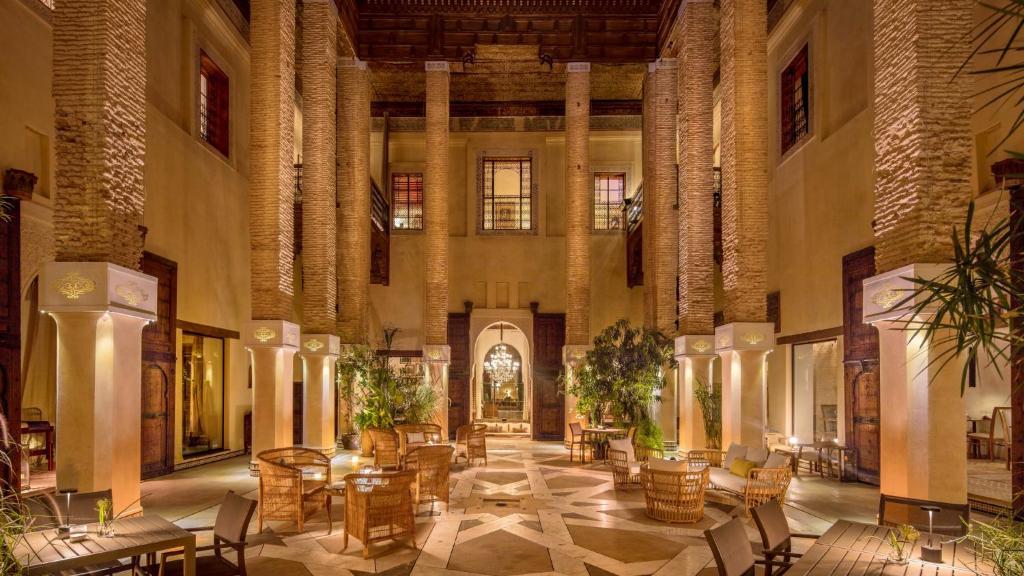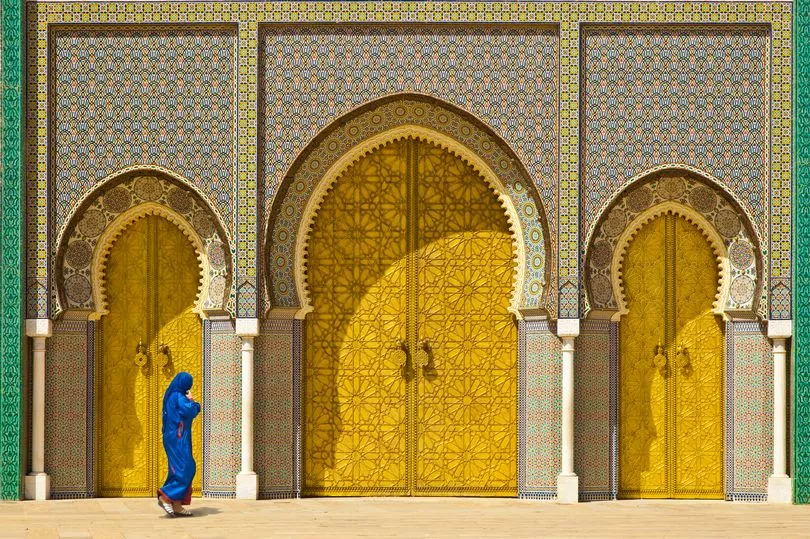
Art historians, architects, engineers and master artisans spent six years restoring a 14th-century royal palace and turning it into the coddling nine-room Riad Fes Maya at the medina’s edge.
Almost all the luxury riads in Fez share the same characteristics, admits Ibtassam Quarraq, the gracious and welcoming manager of one of the city’s most beautiful examples. But a few things make the one she runs stand out.
“What’s unique here is the intricate design,” she says of Riad Fes Maya, where she has worked since the doors opened in 2017. “It’s very detailed. The renovation took a long time”—six years, not counting the years of study and consultation with art historians, professors and architects before the carvers picked up their tools—“and money. We try to make guests feel and experience hundreds of years of living history.”
They try, and they succeed. Riad Fes Maya sits near the edge of the medina in Morocco’s modern-day capital of arts and culture. It occupies a palace that was built in the 14th century by El Pasha of Fez, a mayor-like figure who used the place as his private residence and a meeting point. Its rooftop has wide-angle views of the old imperial city.

The central courtyard of Riad Fes Maya
JOAO SEABRA
In the years that followed, it lived several lives as new owners made changes. In the 15th century, Moors from Andalusia came into the picture, adding art in the style of the Alhambra. By the 16th century, it was operating as something of a museum, displaying the imperial art of Fez and attracting artists and architects who wanted to study the works.
Centuries later, modern-day scholars and craftsmen oversaw its transformation into a sumptuous piece of living history. A little over a decade ago, a local entrepreneur with a strong interest in heritage bought the palace, which by then had fallen into ruins with only “traces of the past left behind.”
This current owner, who describes his job as restoring palaces inside and outside Morocco (including the glorious Riad Rcif Alif in the kernel of Fez’s medina), bringing antique details into the future, and keeping heritage going, nerded out before he splashed out—investing serious cash in preserving this piece of history. He worked with dozens of scholars, engineers and artisans, all from Fez, integrating a burnished fantasy of the palatial past with the modern conveniences European and North American travelers take for granted today.

The imperial suite
JOAO SEABRA
Sure enough, the air-conditioning, wifi and water pressure at Riad Fes Maya work well enough that you can forget about them. What you feel instead is an evocative re-creation of historic grandeur, a quietly dazzling retreat where every detail is just-so. The ornate hand-chiseled cedar of the ceilings, the glimmering zellige mosaics of the floors, the delicate carved plaster of the walls: it was all done by hand with humble equipment, proof that vision and dedication can make magic.
The riad’s nine rooms are spread around the central fountain courtyard. Their names hint at their opulence: the royal suite, the imperial suite, the ambassador suite. But even the unnamed junior suites have a grand luxury of space, original antique furnishings like inlaid tables and elaborately carved writing desks, subtly luminous tadelakt plaster walls and colorful stained glass windows. This is a place where every guest can feel like a royal.
There’s a small spa where therapists give massages and a very traditional, very thorough hammam treatment, with its black soap, scrubbing gloves, argan oil and dousings with rosewater. Although it’s not for the modest, it’s undeniably pampering.

A sitting area
JOAO SEABRA
Also pampering is the attention from the staff, both in the interior courtyard and indoor lounge spaces and on the panoramic rooftop, where kind, friendly servers are quick to appear with mint tea and heavy platters of sweets. (Or they’ll bring a beer from Fez or Casablanca, dry wine from Morocco’s Meknes region or a flute of French Champagne if that’s what guests prefer.) Along with all-day lounging and sunbathing, the rooftop is also open for the daily breakfast that’s included in the rates and for lunch or dinner on request.
They mean it when they describe the food as Moroccan home cooking. The owner’s mother, Fatima, is the executive chef. She makes and oversees everything from the daily-changing breakfast pastries to the beef and prune tagine that’s served in the evening. She clearly puts heart and time into everything she does, like the fluffy couscous, the fragrant tagines, the barbecued lamb and her specialty, a pastilla that layers juicy chicken with almonds, spices and impossibly thin pastry.
There are faster and easier ways of making food, of course, just as there are flashier ingredients. But she isn’t interested in those. And perhaps that’s part of what inspired her son to rebuild Riad Fes Maya as painstakingly as he did, doing everything the traditional way, putting in the hours of hands-on work, refusing to cut a single corner. They’ve both made the intricate assembly of simple materials into something transcendent.

